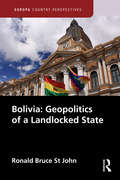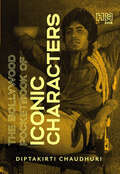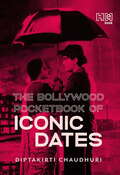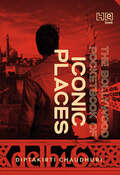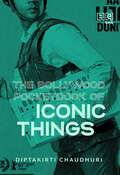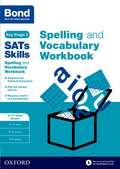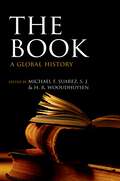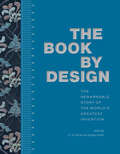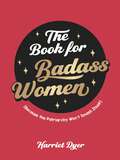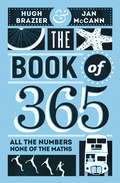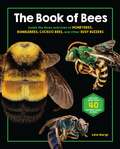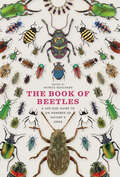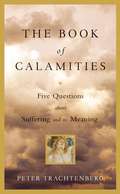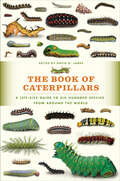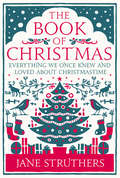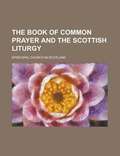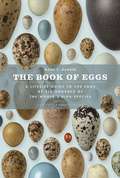- Table View
- List View
Bolivia: Geopolitics of a Landlocked State (Europa Country Perspectives)
by Ronald Bruce St JohnBolivia: Geopolitics of a Landlocked State goes beyond the traditional focus on inter-American relations, territorial issues and the maritime question to provide the first comprehensive study of Bolivian foreign policy from independence to the present day. It aims to redress the balance between the often overstated importance of external determinants – actors and forces outside Bolivia which have influenced the foreign policy process – and the understated impact of internal determinants, similar actors and forces within Bolivia. Drawing on 50 years of research and study, the author focuses on the five interrelated goals of sovereignty, national security, territorial integrity, continental solidarity and economic independence, which have characterized Bolivian foreign policy from the outset. In so doing, the negative impact which poor governance, weak state capacity and a fixation on the seaport issue had on the achievement of those five goals is centre stage in the discussion. In acknowledging the geopolitical ramifications of being landlocked, the singular nature of Bolivia’s approach to the problem also is detailed. An examination of foreign policy today can no longer be confined to intergovernmental relations; instead, it must consider the full range of internal and external forces which have influenced its scope and direction. In addition to bilateral relations, boundary disputes and the seaport issue, this volume explores the impact of foreign capital and multinational companies, together with the effects of domestic entrepreneurs, political parties, labour unions and social movements. It also assesses the overlap or linkage between domestic and foreign variables when the two combined to influence Bolivian foreign policy.
Bolivia: Geopolitics of a Landlocked State (Europa Country Perspectives)
by Ronald Bruce St JohnBolivia: Geopolitics of a Landlocked State goes beyond the traditional focus on inter-American relations, territorial issues and the maritime question to provide the first comprehensive study of Bolivian foreign policy from independence to the present day. It aims to redress the balance between the often overstated importance of external determinants – actors and forces outside Bolivia which have influenced the foreign policy process – and the understated impact of internal determinants, similar actors and forces within Bolivia. Drawing on 50 years of research and study, the author focuses on the five interrelated goals of sovereignty, national security, territorial integrity, continental solidarity and economic independence, which have characterized Bolivian foreign policy from the outset. In so doing, the negative impact which poor governance, weak state capacity and a fixation on the seaport issue had on the achievement of those five goals is centre stage in the discussion. In acknowledging the geopolitical ramifications of being landlocked, the singular nature of Bolivia’s approach to the problem also is detailed. An examination of foreign policy today can no longer be confined to intergovernmental relations; instead, it must consider the full range of internal and external forces which have influenced its scope and direction. In addition to bilateral relations, boundary disputes and the seaport issue, this volume explores the impact of foreign capital and multinational companies, together with the effects of domestic entrepreneurs, political parties, labour unions and social movements. It also assesses the overlap or linkage between domestic and foreign variables when the two combined to influence Bolivian foreign policy.
The Bollywood Pocketbook of Iconic Characters
by Diptakirti ChaudhuriA goddess who defeated the box-office gods. An emperor who was defeated by a slave girl.A child who became an adult too soon. An adult who went the other way.An alcoholic. A teetotaller. A millionaire. A tramp.The Bollywood Pocketbook of Iconic Characters showcases 50 legendary characters that have become icons of Hindi cinema. Characters we have wanted to become. Characters we have loved, hated, lusted after, and even worshipped. Characters with whom we have laughed, for whom we have cried, and whose lives became inspirations for the stories of our own lives.Whether you're a trivia buff or a die hard Bollywood fan, or on your way to converting detractors into becoming one, this must-have book will have you declaring 'Unka naam toh suna hoga!'
The Bollywood Pocketbook of Iconic Dates
by Diptakirti ChaudhuriA Hindi film goes to Cannes. Raj Kapoor goes to Russia.Dilip Kumar stands up in court against Madhubala. Stardust finds itself facing a judge...again!Amitabh Bachchan resurrects himself. Gulshan Kumar is shot dead.The Bollywood Pocketbook of Iconic Dates records 50 momentous dates that mark major breakthroughs in the history of Hindi cinema. Dates on which blockbusters released and started trends. Dates when the country's politics was influenced by a film. And dates on which Hindi cinema changed the world as we knew it!Whether you're a trivia buff or a die hard Bollywood fan, or on your way to converting detractors into becoming one, this must-have book will have you proclaiming 'Tareekh par tareekh, tareekh par tareekh!'
The Bollywood Pocketbook of Iconic Places
by Diptakirti ChaudhuriA studio that became a school. A city that made Bihar cool.A mansion. A single-screen theatre.An icy mountain, a theatre of war. A distant island, a mega-villain's lair.The Bollywood Pocketbook of Iconic Places drops the pin on 50 memorable places that mark milestones in Hindi cinema. Places that started off as shooting locations but became landmarks. Fictional places that have become an indelible part of our childhoods. And a place inspired by a radio frequency!Whether you're a trivia buff or a die hard Bollywood fan, or on your way to converting detractors into becoming one, this must-have book will have you singing 'Yeh kahaan aa gaye hum!'
The Bollywood Pocketbook of Iconic Things
by Diptakirti ChaudhuriA gramophone record that didn't carry a name. A train that went up in flames.Shoes that identified a villain. Shoes that identified a hero.A cap that everyone wanted. A bag of diamonds that no one got.The Bollywood Pocketbook of Iconic Things lists 50 iconic items that have become symbolic of the Hindi film industry. Things that changed the definition of romance. Things that united the nation. Things that define a generation. These are things that have transcended from the movie screens to our lives, things that have kept us awake for many moonlit nights.Whether you're a trivia buff or a die hard Bollywood fan, or on your way to converting detractors into becoming one, this must-have book will have you humming 'Mera kuchh saamaan...!'
Bond SATs Skills Spelling and Vocabulary Stretch Workbook: 10-11+ years
by Michellejoy Hughes Bond SATs SkillsBond SATs Skills Spelling and Vocabulary Stretch for age 10-11 has been developed by Bond with Oxford Dictionaries to enhance ability in English language skills. Both spelling and vocabulary are now keenly examined throughout the National Curriculum and academic testing; this range of titles focuses on the words expected in key assessments.
The Book: A Global History
by Michael F. Suarez H. R. WoudhuysenA concise edition of the highly acclaimed Oxford Companion to the Book, this book features the 51 articles from the Companion plus 3 brand new chapters in one affordable volume. The 54 chapters introduce readers to the fascinating world of book history. Including 21 thematic studies on topics such as writing systems, the ancient and the medieval book, and the economics of print, as well as 33 regional and national histories of 'the book', offering a truly global survey of the book around the world, the Oxford History of the Book is the most comprehensive work of its kind. The three new articles, specially commissioned for this spin-off, cover censorship, copyright and intellectual property, and book history in the Caribbean and Bermuda. All essays are illustrated throughout with reproductions, diagrams, and examples of various typographical features. Beautifully produced and hugely informative, this is a must-have for anyone with an interest in book history and the written word.
The Book by Design: The Remarkable Story of the World's Greatest Invention
by P. J. M. Marks Stephen ParkinA richly illustrated look at some of the British Library’s most beautiful books from around the world. For centuries across the world, books have been created as objects of beauty, with bookmakers lavishing great care on their paper, binding materials, illustrations, and lettering. The Book by Design, featuring an array of books from the British Library's collection, focuses on the sensory experience of holding and reading these objects. Each selection represents a specific moment in the development of what we know today as the book—from scrolls and bound illuminated manuscripts to paperbacks and formatted digital information. These range from the seventh century to the present and include examples from China, Japan, Southeast Asia, the Middle East, Europe, and North America, in addition to a look at book traditions in Africa and Oceania. John James Audubon’s Birds of America, the works of Chaucer, Russian Futurist books, limited editions, historic copies of the Qur’an and the Bible, mass-market paperbacks, and more come together to tell the visual, tactile, artistic, and cultural history of books. Expert curators and specialists explore these books from the perspective of design and manufacturing, original art photographs offer vivid representations of their textures and materials, and graphics detail the size and specifications of each book. Offering a wide-ranging look at the creation and use of books, illustrated with hundreds of color images, this volume is itself an object of beauty.
The Book for Badass Women: (Because the Patriarchy Won’t Smash Itself): An Empowering Guide to Life for Strong Women
by Harriet DyerWhat is a badass woman? Whatever the heck she wants to be! Dive head first into this sassy little book filled with empowering tips and kick-ass quotes.A badass woman is someone who follows her own path, whatever that path may be. She speaks up for what she believes in, she pursues her dreams and she isn’t afraid to stay true to herself.This book will give you all the tools you need to unleash your inner badass. Whether you want to say “no” more often, have the courage to take up physical space or free yourself from the goal of “being likable”, these pages are brimming with tips to help you rip up society’s rule-book and go your own way.The chapters include advice on:Strengthening your self-confidenceStanding up for what you wantGoing after your goalsLifting up and empowering other womenWhether you want to conquer the world with grit, grace or a little bit of both, The Book for Badass Women will help you on your way to being your truest, most badass self. You got this!
The Book of 365: All the Numbers, None of the Maths
by Hugh Brazier Jan McCannEver wondered how many dimples there are on a golf ball; or why the shipping forecast is broadcast on 198 kHz long wave? Find yourself puzzling over what is really going on in the 273 seconds of John Cage’s most famous composition? Then this book of mind-boggling number facts is for you.The Book of 365 offers an entertaining and thought-provoking mini-essay on the world around us for every day of the year, each taking a number between 1 and 365 as its starting point, encompassing science, history, art, literature, medicine, and popular culture, and covering topics as diverse as modern music and meteorites, archaeology and chilli sauce, un-birthdays and radio valve technology.On the way, uncover:At 5, the pentaradial symmetry of starfish and rosesAt 34, how the US flag got its stars and stripesAt 99, the mysteries of the 99 ice-creamAt 239, where Sherlock Holmes really livedAnd, in honour of the leap year, at the end of the book there is a bonus 366th essay!
The Book of Bees: Inside the Hives and Lives of Honeybees, Bumblebees, Cuckoo Bees, and Other Busy Buzzers
by Lela NargiFilled with more than 150 beautiful, crystal-clear photos and bee fun facts, The Book of Bees is the ultimate guide for kids to explore the lives of these stunning insects and learn about their critical role in fostering a sustainable, healthy Earth.Did you know there are blue bees and green bees? Or that one species of bee nests in snail shells? Or that many bees don&’t live in hives? With more than 20,000 species of bees worldwide, there&’s more to bees than just honey! The Book of Bees gives curious kids a close-up view of busy buzzers from around the world. From the familiar Western honeybee to the extra-large Himalayan giant honeybee and Australia&’s vibrant neon cuckoo bee, these pages are packed with detailed photos and fascinating facts on more than 50 species of bees. In-depth species profiles help you identify bees, learn about bee-havior, and find your favorites! And special features examine topics like hive life, nest cells, and other pollinators. The world of bees is exciting and surprising—and The Book of Bees will leave you buzzing!
The Book of Beetles: A Life-Size Guide to Six Hundred of Nature's Gems
by Patrice BouchardWhen renowned British geneticist J. B. S. Haldane was asked what could be inferred about God from a study of his works, Haldane replied, “An inordinate fondness for beetles.” With 350,000 known species, and scientific estimates that millions more have yet to be identified, their abundance is indisputable as is their variety. They range from the delightful summer firefly to the one-hundred-gram Goliath beetle. Beetles offer a dazzling array of shapes, sizes, and colors that entice scientists and collectors across the globe. The Book of Beetles celebrates the beauty and diversity of this marvelous insect. Six hundred significant beetle species are covered, with each entry featuring a distribution map, basic biology, conservation status, and information on cultural and economic significance. Full-color photos show the beetles both at their actual size and enlarged to show details, such as the sextet of spots that distinguish the six-spotted tiger beetle or the jagged ridges of the giant-jawed sawyer beetle. Based in the most up-to-date science and accessibly written, the descriptive text will appeal to researchers and armchair coleopterists alike. The humble beetle continues to grow in popularity, taking center stage in biodiversity studies, sustainable agriculture programs, and even the dining rooms of adventurous and eco-conscious chefs. The Book of Beetles is certain to become the authoritative reference on these remarkably adaptable and beautiful creatures.
The Book of Beetles: A Life-Size Guide to Six Hundred of Nature's Gems
by Patrice BouchardWhen renowned British geneticist J. B. S. Haldane was asked what could be inferred about God from a study of his works, Haldane replied, “An inordinate fondness for beetles.” With 350,000 known species, and scientific estimates that millions more have yet to be identified, their abundance is indisputable as is their variety. They range from the delightful summer firefly to the one-hundred-gram Goliath beetle. Beetles offer a dazzling array of shapes, sizes, and colors that entice scientists and collectors across the globe. The Book of Beetles celebrates the beauty and diversity of this marvelous insect. Six hundred significant beetle species are covered, with each entry featuring a distribution map, basic biology, conservation status, and information on cultural and economic significance. Full-color photos show the beetles both at their actual size and enlarged to show details, such as the sextet of spots that distinguish the six-spotted tiger beetle or the jagged ridges of the giant-jawed sawyer beetle. Based in the most up-to-date science and accessibly written, the descriptive text will appeal to researchers and armchair coleopterists alike. The humble beetle continues to grow in popularity, taking center stage in biodiversity studies, sustainable agriculture programs, and even the dining rooms of adventurous and eco-conscious chefs. The Book of Beetles is certain to become the authoritative reference on these remarkably adaptable and beautiful creatures.
The Book of Beetles: A Life-Size Guide to Six Hundred of Nature's Gems
by Patrice BouchardWhen renowned British geneticist J. B. S. Haldane was asked what could be inferred about God from a study of his works, Haldane replied, “An inordinate fondness for beetles.” With 350,000 known species, and scientific estimates that millions more have yet to be identified, their abundance is indisputable as is their variety. They range from the delightful summer firefly to the one-hundred-gram Goliath beetle. Beetles offer a dazzling array of shapes, sizes, and colors that entice scientists and collectors across the globe. The Book of Beetles celebrates the beauty and diversity of this marvelous insect. Six hundred significant beetle species are covered, with each entry featuring a distribution map, basic biology, conservation status, and information on cultural and economic significance. Full-color photos show the beetles both at their actual size and enlarged to show details, such as the sextet of spots that distinguish the six-spotted tiger beetle or the jagged ridges of the giant-jawed sawyer beetle. Based in the most up-to-date science and accessibly written, the descriptive text will appeal to researchers and armchair coleopterists alike. The humble beetle continues to grow in popularity, taking center stage in biodiversity studies, sustainable agriculture programs, and even the dining rooms of adventurous and eco-conscious chefs. The Book of Beetles is certain to become the authoritative reference on these remarkably adaptable and beautiful creatures.
The Book of Beetles: A Life-Size Guide to Six Hundred of Nature's Gems
by Patrice BouchardWhen renowned British geneticist J. B. S. Haldane was asked what could be inferred about God from a study of his works, Haldane replied, “An inordinate fondness for beetles.” With 350,000 known species, and scientific estimates that millions more have yet to be identified, their abundance is indisputable as is their variety. They range from the delightful summer firefly to the one-hundred-gram Goliath beetle. Beetles offer a dazzling array of shapes, sizes, and colors that entice scientists and collectors across the globe. The Book of Beetles celebrates the beauty and diversity of this marvelous insect. Six hundred significant beetle species are covered, with each entry featuring a distribution map, basic biology, conservation status, and information on cultural and economic significance. Full-color photos show the beetles both at their actual size and enlarged to show details, such as the sextet of spots that distinguish the six-spotted tiger beetle or the jagged ridges of the giant-jawed sawyer beetle. Based in the most up-to-date science and accessibly written, the descriptive text will appeal to researchers and armchair coleopterists alike. The humble beetle continues to grow in popularity, taking center stage in biodiversity studies, sustainable agriculture programs, and even the dining rooms of adventurous and eco-conscious chefs. The Book of Beetles is certain to become the authoritative reference on these remarkably adaptable and beautiful creatures.
The Book of Calamities: Five Questions About Suffering and Its Meaning
by Peter TrachtenbergWhat does it mean to suffer? What enables some people to emerge from tragedy while others are spiritually crushed by it? Why do so many Americans think of suffering as something that happens to other people -- who usually deserve it? These are some of the questions at the heart of this powerful book. Combining reportage, personal narrative, and moral philosophy, Peter Trachtenberg tells the stories of grass-roots genocide tribunals in Rwanda and tsunami survivors in Sri Lanka, an innocent man on death row, and a family bereaved on 9/11. He examines texts from the Book of Job to the Bodhicharyavatara and the writings of Simone Weil. The Book of Calamities is a provocative and sweeping look at one of the biggest paradoxes of the human condition -- and the surprising strength and resilience of those who are forced to confront it.
The Book of Caterpillars: A Life-Size Guide to Six Hundred Species from around the World
by David G. JamesThe weird and wonderful world of insects boasts some of the strangest creatures found in nature, and caterpillars are perhaps the most bizarre of all. While most of us picture caterpillars as cute fuzzballs munching on leaves, there is much more to them than we imagine. A caterpillar’s survival hinges on finding enough food and defending itself from the array of natural enemies lined up to pounce and consume. And the astounding adaptations and strategies they have developed to maximize their chances of becoming a butterfly or moth are only just beginning to be understood, from the Spicebush Swallowtail caterpillar that resembles a small snake to the Eastern Carpenter Bee Hawkmoth caterpillar that attempts to dissuade potential predators by looking like a diseased leaf. The Book of Caterpillars unveils the mysteries of six hundred species from around the world, introducing readers to the complexity and beauty of these underappreciated insects. With the advent of high-quality digital macrophotography, the world of caterpillars is finally opening up. The book presents a wealth of stunning imagery that showcases the astonishing diversity of caterpillar design, structure, coloration, and patterning. Each entry also features a two-tone engraving of the adult specimen, emphasizing the wing patterns and shades, as well as a population distribution map and table of essential information that includes their habitat, typical host plants, and conservation status. Throughout the book are fascinating facts that will enthrall expert entomologists and curious collectors alike. A visually rich and scientifically accurate guide to six hundred of the world’s most peculiar caterpillars, this volume presents readers with a rare, detailed look at these intriguing forms of insect life.
The Book of Caterpillars: A Life-Size Guide to Six Hundred Species from around the World
by David G. JamesThe weird and wonderful world of insects boasts some of the strangest creatures found in nature, and caterpillars are perhaps the most bizarre of all. While most of us picture caterpillars as cute fuzzballs munching on leaves, there is much more to them than we imagine. A caterpillar’s survival hinges on finding enough food and defending itself from the array of natural enemies lined up to pounce and consume. And the astounding adaptations and strategies they have developed to maximize their chances of becoming a butterfly or moth are only just beginning to be understood, from the Spicebush Swallowtail caterpillar that resembles a small snake to the Eastern Carpenter Bee Hawkmoth caterpillar that attempts to dissuade potential predators by looking like a diseased leaf. The Book of Caterpillars unveils the mysteries of six hundred species from around the world, introducing readers to the complexity and beauty of these underappreciated insects. With the advent of high-quality digital macrophotography, the world of caterpillars is finally opening up. The book presents a wealth of stunning imagery that showcases the astonishing diversity of caterpillar design, structure, coloration, and patterning. Each entry also features a two-tone engraving of the adult specimen, emphasizing the wing patterns and shades, as well as a population distribution map and table of essential information that includes their habitat, typical host plants, and conservation status. Throughout the book are fascinating facts that will enthrall expert entomologists and curious collectors alike. A visually rich and scientifically accurate guide to six hundred of the world’s most peculiar caterpillars, this volume presents readers with a rare, detailed look at these intriguing forms of insect life.
The Book of Caterpillars: A Life-Size Guide to Six Hundred Species from around the World
by David G. James Sally Morgan Andrei SourakovThe weird and wonderful world of insects boasts some of the strangest creatures found in nature, and caterpillars are perhaps the most bizarre of all. While most of us picture caterpillars as cute fuzzballs munching on leaves, there is much more to them than we imagine. A caterpillar’s survival hinges on finding enough food and defending itself from the array of natural enemies lined up to pounce and consume. And the astounding adaptations and strategies they have developed to maximize their chances of becoming a butterfly or moth are only just beginning to be understood, from the Spicebush Swallowtail caterpillar that resembles a small snake to the Eastern Carpenter Bee Hawkmoth caterpillar that attempts to dissuade potential predators by looking like a diseased leaf. The Book of Caterpillars unveils the mysteries of six hundred species from around the world, introducing readers to the complexity and beauty of these underappreciated insects. With the advent of high-quality digital macrophotography, the world of caterpillars is finally opening up. The book presents a wealth of stunning imagery that showcases the astonishing diversity of caterpillar design, structure, coloration, and patterning. Each entry also features a two-tone engraving of the adult specimen, emphasizing the wing patterns and shades, as well as a population distribution map and table of essential information that includes their habitat, typical host plants, and conservation status. Throughout the book are fascinating facts that will enthrall expert entomologists and curious collectors alike. A visually rich and scientifically accurate guide to six hundred of the world’s most peculiar caterpillars, this volume presents readers with a rare, detailed look at these intriguing forms of insect life.
The Book of Caterpillars: A Life-Size Guide to Six Hundred Species from around the World
The weird and wonderful world of insects boasts some of the strangest creatures found in nature, and caterpillars are perhaps the most bizarre of all. While most of us picture caterpillars as cute fuzzballs munching on leaves, there is much more to them than we imagine. A caterpillar’s survival hinges on finding enough food and defending itself from the array of natural enemies lined up to pounce and consume. And the astounding adaptations and strategies they have developed to maximize their chances of becoming a butterfly or moth are only just beginning to be understood, from the Spicebush Swallowtail caterpillar that resembles a small snake to the Eastern Carpenter Bee Hawkmoth caterpillar that attempts to dissuade potential predators by looking like a diseased leaf. The Book of Caterpillars unveils the mysteries of six hundred species from around the world, introducing readers to the complexity and beauty of these underappreciated insects. With the advent of high-quality digital macrophotography, the world of caterpillars is finally opening up. The book presents a wealth of stunning imagery that showcases the astonishing diversity of caterpillar design, structure, coloration, and patterning. Each entry also features a two-tone engraving of the adult specimen, emphasizing the wing patterns and shades, as well as a population distribution map and table of essential information that includes their habitat, typical host plants, and conservation status. Throughout the book are fascinating facts that will enthrall expert entomologists and curious collectors alike. A visually rich and scientifically accurate guide to six hundred of the world’s most peculiar caterpillars, this volume presents readers with a rare, detailed look at these intriguing forms of insect life.
The Book of Christmas: Everything We Once Knew And Loved About Christmastime
by Jane Struthers- What is the significance of holly at Christmas?- When should you make your figgy pudding?- Why was the Old Lad's Passing Bell rung on Christmas Eve? - And who was Good King Wenceslas?Did you know that, long before turkey arrived on our shores, it was traditional to serve a roasted wild boar's head at Christmas? Or that our Christmases were once so cold that Frost Fairs were held on the River Thames? Christmas Day was first celebrated on 25 December in the fourth century CE. But when should our Christmas decorations come down - Twelfth Day, Twelfth Night ... or Candlemas? And why? Packed with fascinating facts about ancient religious customs and traditional feasts, instructions for Victorian parlour games and the stories behind our favourite carols, The Book of Christmas is a captivating volume about our Christmas past.
The Book of Common Prayer / and The Scottish Liturgy
by Episcopal Church in ScotlandPrayerbook of the Episcopal Church in Scotland
The Book of Eggs: A Life-Size Guide to the Eggs of Six Hundred of the World's Bird Species
by Mark E. HauberFrom the brilliantly green and glossy eggs of the Elegant Crested Tinamou—said to be among the most beautiful in the world—to the small brown eggs of the house sparrow that makes its nest in a lamppost and the uniformly brown or white chickens’ eggs found by the dozen in any corner grocery, birds’ eggs have inspired countless biologists, ecologists, and ornithologists, as well as artists, from John James Audubon to the contemporary photographer Rosamond Purcell. For scientists, these vibrant vessels are the source of an array of interesting topics, from the factors responsible for egg coloration to the curious practice of “brood parasitism,” in which the eggs of cuckoos mimic those of other bird species in order to be cunningly concealed among the clutches of unsuspecting foster parents. The Book of Eggs introduces readers to eggs from six hundred species—some endangered or extinct—from around the world and housed mostly at Chicago’s Field Museum of Natural History. Organized by habitat and taxonomy, the entries include newly commissioned photographs that reproduce each egg in full color and at actual size, as well as distribution maps and drawings and descriptions of the birds and their nests where the eggs are kept warm. Birds’ eggs are some of the most colorful and variable natural products in the wild, and each entry is also accompanied by a brief description that includes evolutionary explanations for the wide variety of colors and patterns, from camouflage designed to protect against predation, to thermoregulatory adaptations, to adjustments for the circumstances of a particular habitat or season. Throughout the book are fascinating facts to pique the curiosity of binocular-toting birdwatchers and budding amateurs alike. Female mallards, for instance, invest more energy to produce larger eggs when faced with the genetic windfall of an attractive mate. Some seabirds, like the cliff-dwelling guillemot, have adapted to produce long, pointed eggs, whose uneven weight distribution prevents them from rolling off rocky ledges into the sea. A visually stunning and scientifically engaging guide to six hundred of the most intriguing eggs, from the pea-sized progeny of the smallest of hummingbirds to the eggs of the largest living bird, the ostrich, which can weigh up to five pounds, The Book of Eggs offers readers a rare, up-close look at these remarkable forms of animal life.
The Book of Eggs: A Life-Size Guide to the Eggs of Six Hundred of the World's Bird Species
by Mark E. HauberFrom the brilliantly green and glossy eggs of the Elegant Crested Tinamou—said to be among the most beautiful in the world—to the small brown eggs of the house sparrow that makes its nest in a lamppost and the uniformly brown or white chickens’ eggs found by the dozen in any corner grocery, birds’ eggs have inspired countless biologists, ecologists, and ornithologists, as well as artists, from John James Audubon to the contemporary photographer Rosamond Purcell. For scientists, these vibrant vessels are the source of an array of interesting topics, from the factors responsible for egg coloration to the curious practice of “brood parasitism,” in which the eggs of cuckoos mimic those of other bird species in order to be cunningly concealed among the clutches of unsuspecting foster parents. The Book of Eggs introduces readers to eggs from six hundred species—some endangered or extinct—from around the world and housed mostly at Chicago’s Field Museum of Natural History. Organized by habitat and taxonomy, the entries include newly commissioned photographs that reproduce each egg in full color and at actual size, as well as distribution maps and drawings and descriptions of the birds and their nests where the eggs are kept warm. Birds’ eggs are some of the most colorful and variable natural products in the wild, and each entry is also accompanied by a brief description that includes evolutionary explanations for the wide variety of colors and patterns, from camouflage designed to protect against predation, to thermoregulatory adaptations, to adjustments for the circumstances of a particular habitat or season. Throughout the book are fascinating facts to pique the curiosity of binocular-toting birdwatchers and budding amateurs alike. Female mallards, for instance, invest more energy to produce larger eggs when faced with the genetic windfall of an attractive mate. Some seabirds, like the cliff-dwelling guillemot, have adapted to produce long, pointed eggs, whose uneven weight distribution prevents them from rolling off rocky ledges into the sea. A visually stunning and scientifically engaging guide to six hundred of the most intriguing eggs, from the pea-sized progeny of the smallest of hummingbirds to the eggs of the largest living bird, the ostrich, which can weigh up to five pounds, The Book of Eggs offers readers a rare, up-close look at these remarkable forms of animal life.
